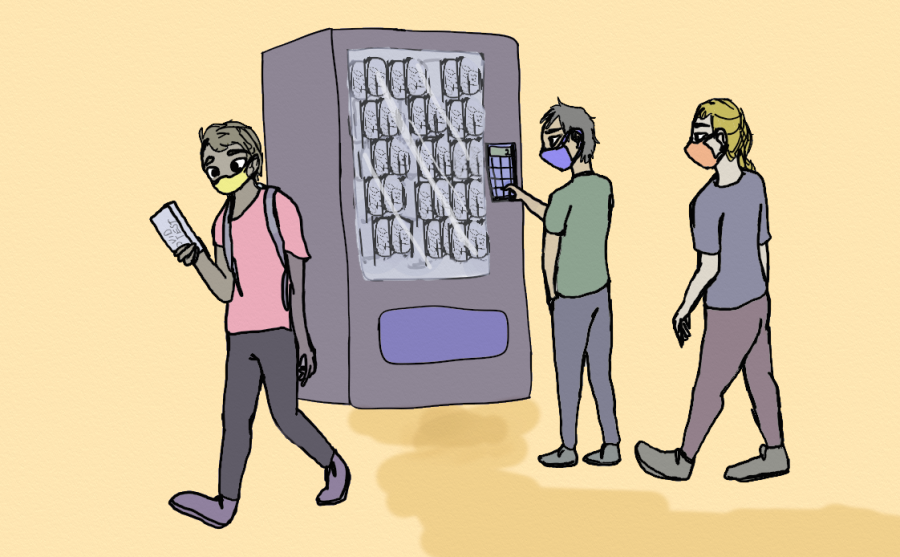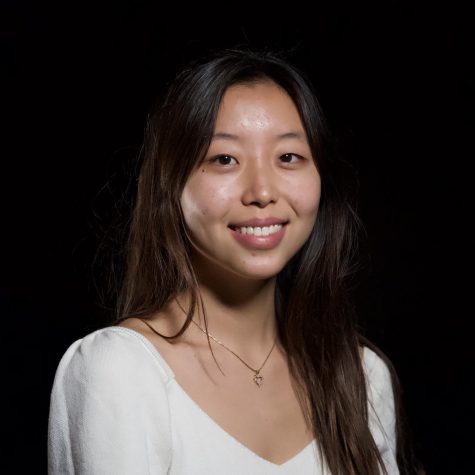Instead of having candy bars and other snacks, vending machines around UC San Diego feature COVID-19 self administered tests as a part of the “new normal.”
The threat of the COVID-19 virus settled slowly — like a leaky faucet. COVID-19’s deceptive trickles, though, ended up filling a bucket of water that overflowed, causing issues not just for a few but for many. The virus uprooted settled communities and developed into a notorious household name in what started as another school email alert.
The process felt like a slow attrition to many — a short upheaval of traditions and then the more long-lasting adjustment to a “new” normal. Adapting to the pandemic also highlighted a time of immense scrutiny on understanding the disease — something that meant that previously established measures evolved into more fleshed out ones. Testing, for one, grew not just to be a last-minute method, but a necessary safety precaution for anyone to take.
As of Jan. 13, according to the Return to Learn Weekly newsletter, ten blue COVID test vending machines arrived on campus, with nine more coming soon in locations from Osler Parking Garage to the Jacobs School of Engineering.
The vending machines, part of a process that started on Jan. 2, offer current UCSD students, campus staff, and faculty the opportunity to obtain a test on a weekly basis and self-administer the test themselves. Further, because there is no appointment or cost involved, testing can be all the more convenient and accessible.
In fact, students who study remotely and come onto campus sometimes as well as students who live around campus can access the vending machines. This is crucial because while students on campus absolutely must test once a week, visitors too must test themselves before stepping onto campus.
The process is similar to other self-testing COVID-19 services — inside of the bag, there is a sterile swab for the nostrils and a test tube. Upon signing into their personal UCSD app, the testee can scan their test kit. After finishing the swabbing, one can leave the vials at drop boxes next to the vending machines. Then, within a day or so, results are posted on the MyChart health app.
In-person testing sites still include the Price Center clinic, Athena Circle, or a drive-thru location (though these may have limited spaces).
“The concept of a vending machine with tests is super cool and useful,” Eleanor Roosevelt College sophomore Sanika Walimbe said. “The ability for anyone to get tested when they want without an appointment and having to possibly be exposed to more COVID-inducing scenarios is smart. I really hope they become normal around campus so that rapid testing and public safety can improve.”
In early May, following a time when COVID-19 cases were expanding across the U.S. (though they hadn’t hit UCSD yet), UCSD enacted the Return to Learn program. The Return to Learn program arose so that in-person teaching, learning, and more could resume amidst the COVID-19 pandemic, with safety being the main priority.
The resumption of in-person appearances came with some limitations regarding the number of people on campus. These constraints became a necessary part of the compromise to accommodate students who could not return home or wanted to stay and address campus density problems.
When remote learning commenced in Spring Quarter 2020, Chancellor Khosla addressed density issues of individuals on campus by encouraging those to leave campus if they were able. Even during Winter Quarter 2021, density issues remain crucial to confront. According to the Return to Learn program on the UCSD website, less than 10 percent of the Winter 2021 undergraduate class sections are in-person. As of now, if classes are in-person, they will be conducted outside.
The three pillars of the Return to Learn program include transmission-reductive strategies, monitoring viral activity, and public health interventions.
The first strategy tackles prevention or reduction methods. After all, amidst investment in tests and tools that oversee the virus spread, preventative measures did not lessen in importance. This entailed plentiful encouragement to social distance (which is also why campus density reduced), to wear masks, and to sanitize one’s hands and common areas. These fall under transmission-reductive strategies as they reduce the likelihood that one would be infected.
The second strategy focuses on innovation to aid early detection of the COVID-19 virus and observe its spread as well as accommodate testing for individuals. The vending machines are just one of the newest installments of this Return to Learn program that combat this. One of the quite striking tools to check for COVID-19, too, is stool testing through the wastewater detection system. The system checks for the virus that causes COVID-19 shed in these waters — all before someone develops clinical symptoms. UCSD checks these systems — of which there are 70 active samplers — every day. Any discovery of a positive sample encourages those in that area to test immediately or to monitor their own symptoms.
Public health interventions involve being vigilant about who tests positive, seeing to it that they are isolated in designated housing, and understanding who has been in contact with them.
Apps like the CA Notify Exposure System, which will not release one’s personal identity or location, lets the individual of their phone know if they’ve been in contact with someone who tested positive. Around December, it became available for all Californians, but its roots originated in UCSD.
These measures are crucial and increasingly so because, according to the current California COVID-19 data, California has had about three million cases of COVID-19, resulting in over thirty-two thousand deaths.
Based on daily dashboard reports by UCSD regarding student testing, since March 2020–around the same time there have been reported positive cases on campus– there have been 792 cases in total. Currently, for Winter Quarter 2021, there are 7,306 students living on campus, but tests include all enrolled UCSD undergraduate students and graduate students along with extension students coming to on-campus classes.
This is still below-average, relative to San Diego county, according to its site monitoring the virus, which has a rate of about 6,262 COVID-19 cases per 100,000 tests at this current time.
UCSD has strongly adhered to the Swiss Cheese Model, a model that doesn’t see measures like social distancing or washing one’s hands alone as the holy grail. Rather, these lines of defense must be utilized together to ensure risks of transmission are accounted for.
According to the American Institute of Physics, researchers conducted a test on five different material masks with a machine that used an air generator to imitate the coughs and sneezes of people; the results were that masks do facilitate the blocking of the particles. However, this is compromised when social distancing of at least six feet is not done.
Then, the question emerges. Without stringent measures UCSD took on, what could be the set of potential results for campus life?
A Los Angeles Times article by Colleen Shalby notes the measures taken on university campuses to safeguard students and the community from COVID-19, but the problem is seeing student compliance, particularly within the students who live off-campus and are not bound by the rules.
Perhaps, then, this is indicative not just of the significance of measures but also individuals themselves taking direct action to be safe and keeping those around them safe.
The winter quarter is now underway, but COVID-19 continues to prove itself to be quite a commanding presence. There is strength here. Some individuals see the measures taken to combat COVID-19 as proof of fear or weakness against authority. But there seems to be a kind of quiet power in being cautious for oneself and for others. Tools such as the UCSD vending machines are just one of some stunning reminders of ingenuity out of urgency — actions taken not out of fear, but for a desire for normalcy and health in the community.
Art by Kalo Grimsby for The UCSD Guardian.















